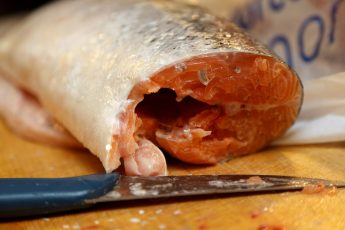Introduction
Quick Navigation
You have a knife set, and you know about the different knives included in the collection. You can quickly see the bread knife, and the one that sticks out the most (so to speak) is the gigantic chef’s knife. You also can distinguish between the paring and small utility knives quickly. However, there are two knives that novice chefs or the average individual ignore. Those knives are the boning knife and the fillet knife.
That is too bad that those two knives are the ones that are the least recognizable since they are instrumental when it comes to food preparation. The boning knife and fillet knife both share a curved edge to the blade, so they appear similar. However, they are very different. Let’s now talk about these knives in detail and compare them.
What Is The Boning Knife?
The boning knife is a long thin knife as the flat blade features measures from five to seven inches long. The edge is straight and has a sharp tip that has a slight curve. This knife aims to cut tough meats and use it to easily separate the flesh from the bone, cartilage, and fat. You can use a boning knife for removing bones from fish and other foods such as vegetables, fruits, and baked goods. You can use boning knives to cut mangoes and apple cores, for instance. And it is understandable how chefs would use a boning knife to cut fruits in addition to meat.
However, why would you use a boning knife that cuts away apple cores and tough meat neatly away from bones and gristle for cutting baked goods? That seems not to make sense since you can quickly cut cakes and pastries with regular butter knives. However, boning knives are good for creating fun designs on baked goods and flattening curved cakes. That is why so many bakers have boning knives. They don’t need to separate the flesh from bones and cartilage, but they are an excellent tool for preparing and designing baked goods. You can use them to core cupcakes and cut cookie dough, for example. Therefore, you don’t only need to use boning knives on meat, even though it makes the most sense to use it. However, a boning knife cannot do the same job as a fillet knife and vice versa. Let’s talk more about the fillet knife.
What Is The Fillet Knife?
The fillet knife is more flexible and thinner than the boning knife, and this knife is more flexible than other knives. The blade measures at around five to nine inches and features a curve that points upward. The tip at the edge is very sharp and curved. However, since the blade is skinny, it will break if you attempt to debone meat with it as you do with a boning knife. You cannot compare it to a chef’s knife as it cannot handle that role for food preparation.
The fillet knife is excellent for removing scales and the skin from fish, and it can maneuver around the fish without it ruining the delicate flesh. That is one purpose of the fillet knife. You can also do with the knife to quickly cut a whole fish up into fillets cleanly and neatly. You can compare fillet knives to surgical instruments as the design of them are to cut fish around the skin and bones precisely. You can technically use a boning knife to cut away the skin from fish, but it will not provide you with the same result. You won’t end up with a clean cut of fish if you use a boning knife instead of the fillet knife. The bottom line is that a boning knife works best among tougher foods or foods that you can design with the knife, and many cuts of fish can be too delicate for a boning knife. Fillet knives are the ones that can cut softer and light foods such as fish.
Another feature of the fillet knife is that it has a slope that is long and shallow-angled. That is why the blade is exceptionally sharp but not nearly as durable as the boning knife and chef’s knife. Therefore, you will not find this knife used in butcher shops because there is no place for them. Fillet knives will not last if butchers use them. However, now that you know those fillet knives are not tools that butchers can use are they suitable for foods other than fish? Yes, you can use fillet knives on other foods.
You can use fillet knives to prepare fruits and vegetables. These knives are good for segmenting oranges, lemons, and other citrus fruits and removing the fruit’s rinds. If you want to have fun sculpting vegetables and fruits for decoration, the fillet knife is suitable for that too.
Conclusion
As you can see, there are plenty of differences between boning knives and fillet knives. Fillet knives cut fish and do not have the purpose of removing bones, but boning blades cut meat, fish, and other foods delicately and cleanly. That is the main difference between the two knives. However, both knives require the same type of care.
You need to delicately clean them with a soft cloth or sponge after using mild soap and water. Don’t put the knives in the dishwasher as they are too fragile to handle that type of wash. Dry the blades with a clean and soft cloth and then store them in the knife set. Never leave either of the knives loose in the kitchen drawer, or else neither will last.
You also want to sharpen both knives‘ regularly. You want these knives to last you a long time, and if you sharpen them and store them well, and clean them delicately, then they will last for years to come. If you do not know what types of knives you have in your knife set, take them out, and study them. Read the descriptions of the boning knife and the fillet knife, and then you will recognize them. If you misused the blades in the past for purposes not intended for their use, you could correct that for the future.

